How Can You Scrape Cruise Critic U.S. Reviews for Actionable Insights?
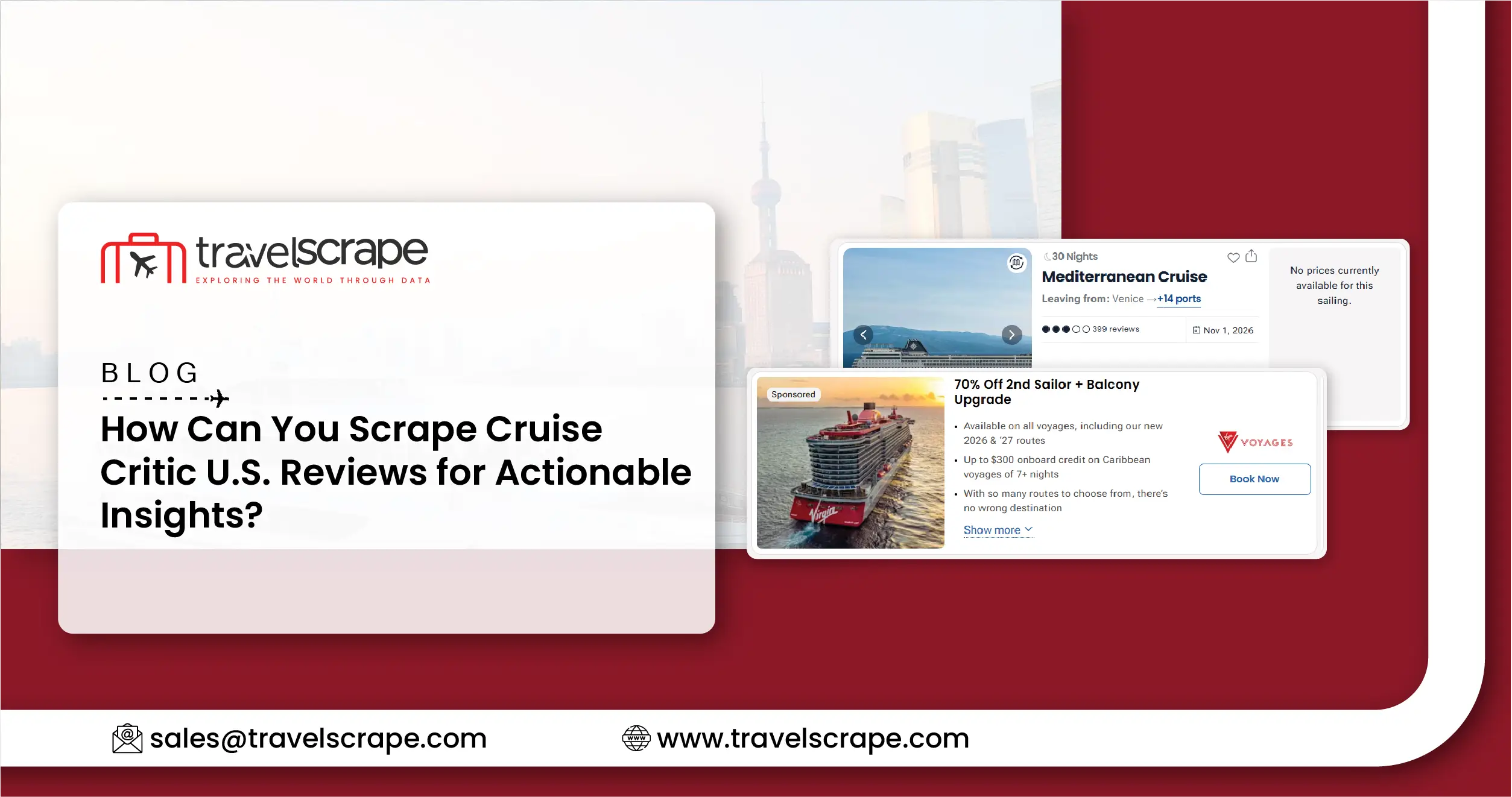
Introduction
Over the past decade, the cruising industry has undergone significant transformation, with travelers increasingly relying on platforms like Cruise Critic for trustworthy reviews and recommendations. For cruise lines, travel agencies, and data analysts, understanding these insights is crucial to remain competitive and responsive to passenger needs. Passenger reviews offer a wealth of information on cabins, excursions, dining experiences, and overall satisfaction, which, when analyzed systematically, can guide strategic decisions and operational improvements. Leveraging web scraping techniques allows stakeholders to efficiently collect, organize, and analyze this vast volume of feedback, turning qualitative opinions into actionable data. By implementing tools to Scrape Cruise Critic U.S. reviews strategies, companies can identify emerging trends, monitor customer sentiment, and optimize their offerings in real-time. Furthermore, integrating this information with broader resources like the Global Cruise Route Dataset enables a comprehensive understanding of route popularity, seasonal trends, and passenger preferences across the U.S. cruise market.
Understanding the Importance of Cruise Critic Reviews
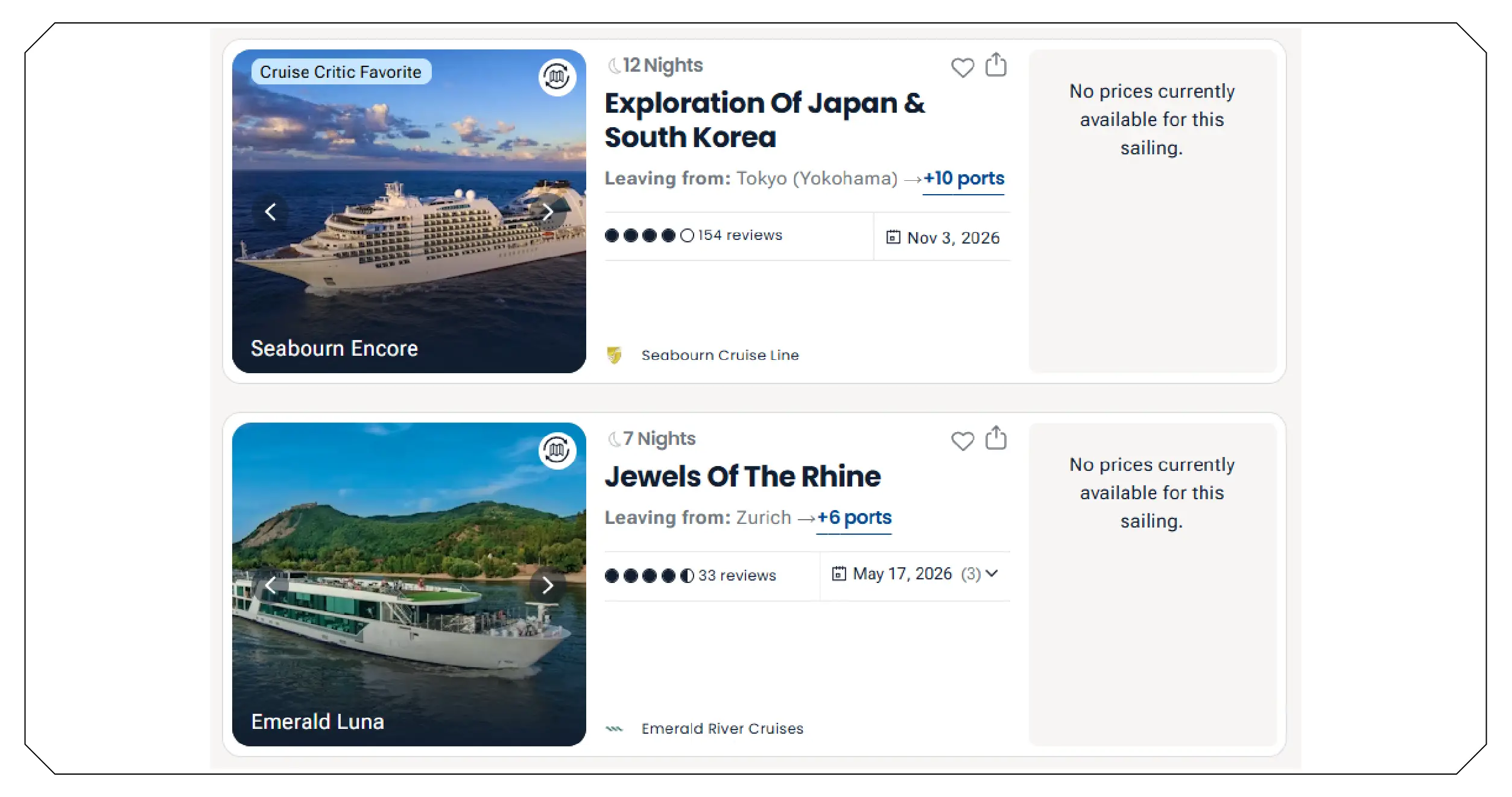
Cruise Critic has established itself as a go-to platform for cruise passengers, providing detailed feedback on cruise lines, itineraries, onboard experiences, excursions, cabins, and dining. Each review carries rich insights into passenger satisfaction, preferences, and expectations. By analyzing these reviews systematically, cruise operators can identify patterns and trends that directly influence business decisions.
With the ability to perform Cruise Critic feedback extraction, analysts can capture sentiments from thousands of user reviews efficiently. This process eliminates the need for manual collection, which is both time-consuming and prone to error. By automating data extraction, travel agencies and cruise companies can monitor passenger experiences in near real-time and refine their strategies accordingly.
Methodologies for Scraping Cruise Critic U.S. Reviews
1. Selecting the Target Data
The first step in scraping Cruise Critic reviews is identifying which data points are valuable. Typically, analysts focus on:
- Cruise line and ship name
- Departure and arrival ports
- Travel dates and duration
- Cabin type and associated ratings
- Dining experience and onboard amenities
- Excursion feedback and shore activities
- Overall passenger rating and textual feedback
Targeting these fields ensures that the extracted data is both comprehensive and actionable. This is especially important when compiling datasets like the Cruise Critic ratings extraction, which quantifies satisfaction across multiple dimensions of the cruise experience.
2. Web Scraping Tools and Techniques
To collect Cruise Critic reviews efficiently, various scraping techniques can be employed. Python libraries such as BeautifulSoup, Selenium, and Scrapy are widely used due to their flexibility and efficiency in handling dynamic content.
- BeautifulSoup: Ideal for parsing HTML pages and extracting structured data.
- Selenium: Best for navigating interactive pages with AJAX or JavaScript elements.
- Scrapy: Useful for large-scale scraping with built-in support for request handling, pipelines, and exporting data to formats like CSV or JSON.
By combining these tools, analysts can build a robust pipeline for Cruise Critic Itineraries Dataset creation, capturing details on routes, ports of call, and passenger feedback.
3. Data Cleaning and Transformation
Raw scraped data often contains noise such as HTML tags, emojis, or inconsistent formats. Cleaning and transforming this data is crucial for meaningful analysis. Key steps include:
- Removing HTML tags and special characters
- Normalizing text for sentiment analysis
- Standardizing ratings into a standard numerical scale
- Handling missing or incomplete reviews
After cleaning, the data becomes suitable for integration with other sources, like U.S. cruise passenger demographics, enabling enhanced analysis of customer preferences.
Key Objectives of Cruise Critic Review Scraping
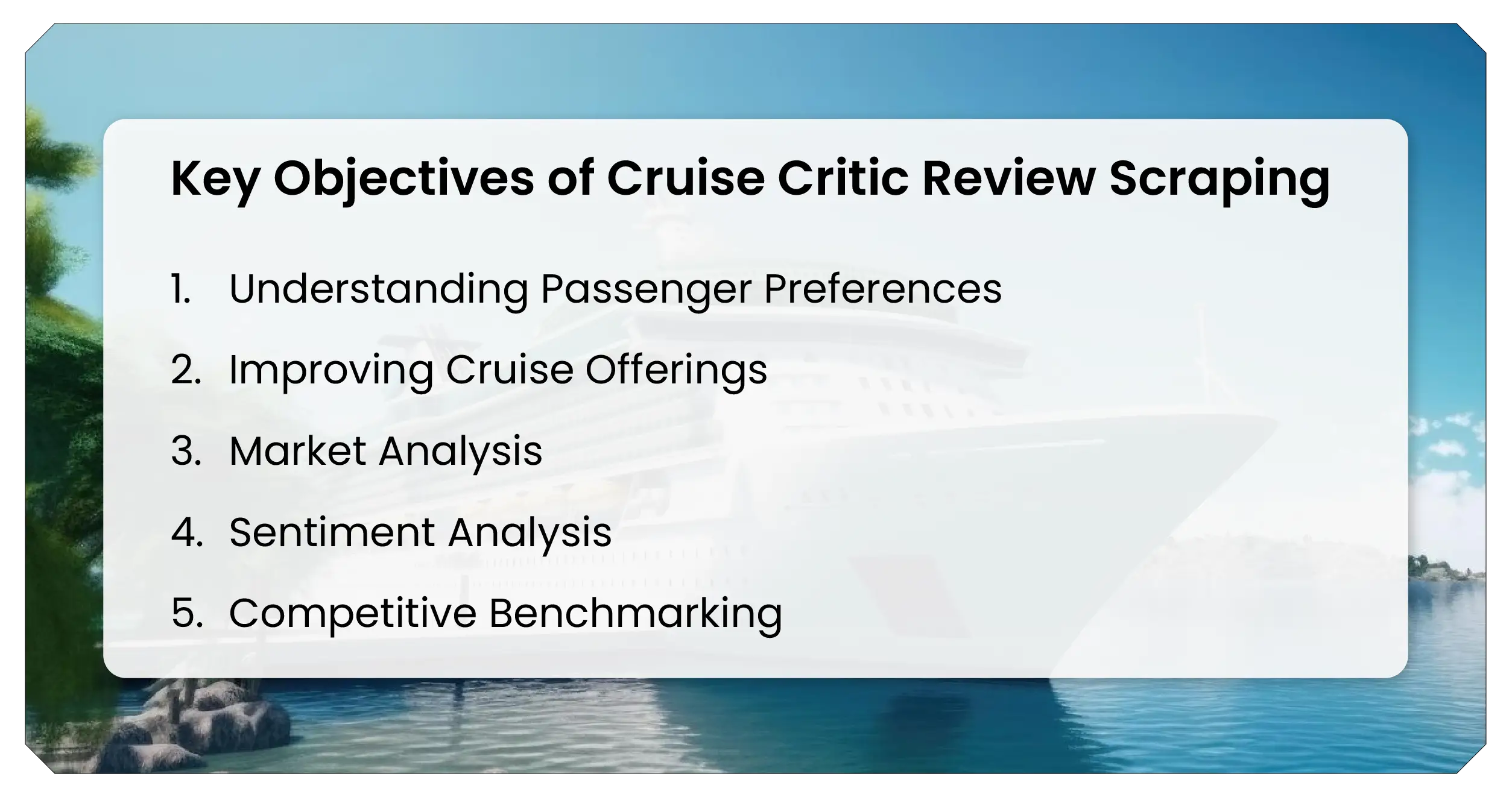
Scraping Cruise Critic U.S. reviews serves multiple objectives:
- Understanding Passenger Preferences: Extracting detailed feedback allows cruise operators to identify which cabins, amenities, or excursions are most popular.
- Improving Cruise Offerings: By analyzing negative feedback, companies can address pain points, enhancing the onboard experience for future passengers.
- Market Analysis: Aggregating reviews across different cruise lines and itineraries provides insights into industry trends, helping travel agencies make data-driven recommendations.
- Sentiment Analysis: With text mining and natural language processing (NLP), sentiment scores can be assigned to passenger reviews to quantify satisfaction levels.
- Competitive Benchmarking: By monitoring reviews for competing cruise lines, businesses can benchmark their offerings against industry leaders and adapt accordingly.
Collecting these insights through U.S. cruise experience data scraping enables data-driven decisions that improve both operational efficiency and passenger satisfaction.
Constructing a Cruise Critic Dataset for Analysis
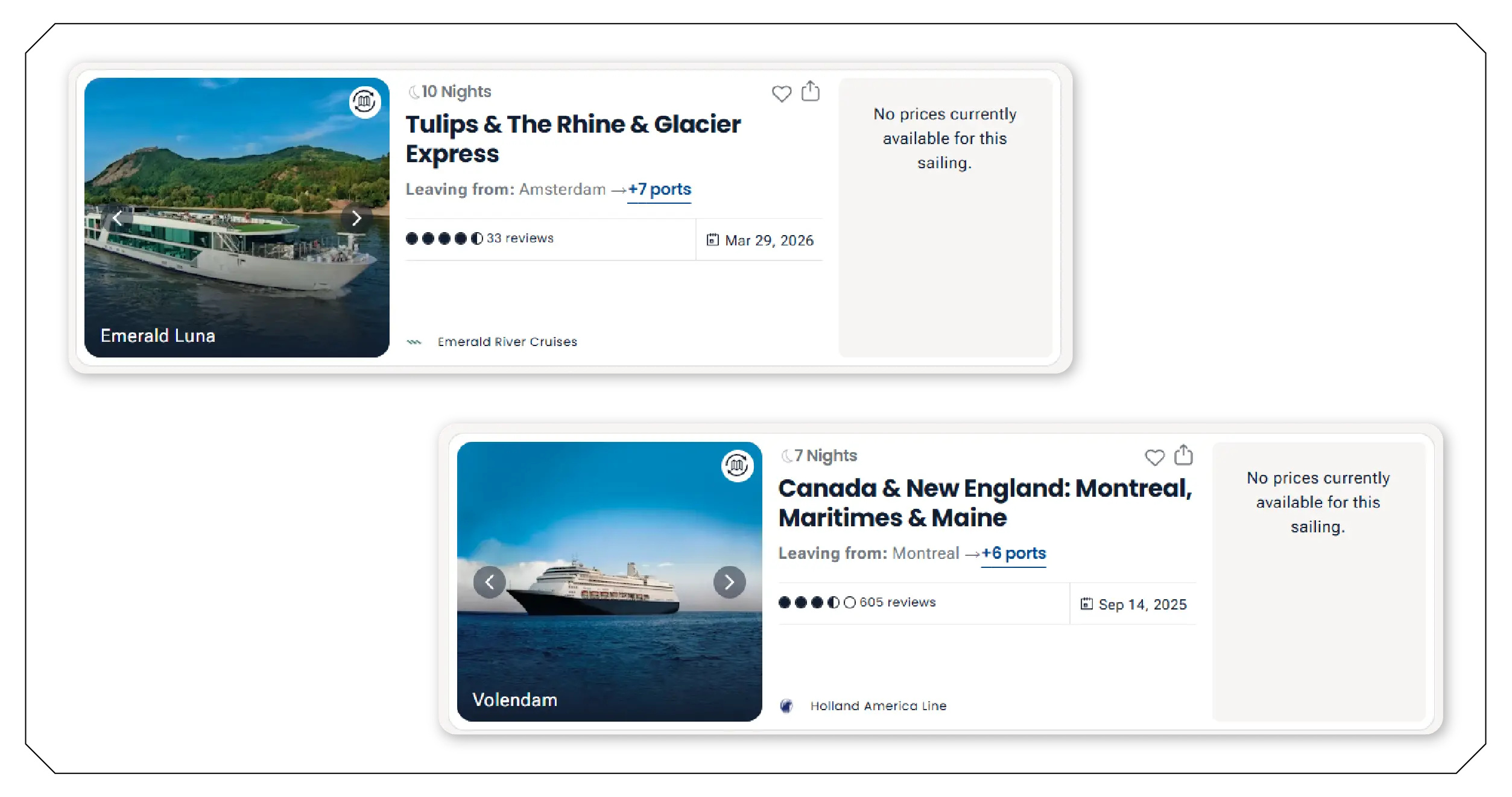
A well-structured dataset is essential for meaningful analysis. Typically, a Cruise Critic Dataset for Analysis includes multiple columns, such as:
| Cruise Line | Ship Name | Departure Port | Destination | Cabin Type | Review Date | Rating | Review Text | Excursion Feedback | Dining Feedback | Overall Sentiment |
This structure allows analysts to perform both quantitative and qualitative analyses. For example, ratings can be used to identify high-performing ships, while textual reviews can reveal recurring issues or highlight popular excursions.
By incorporating data from the Cruise Critic passenger review scraping for the U.S., businesses can enrich their insights with location-specific preferences, seasonal trends, and demographic patterns.
Real-World Applications of Cruise Critic Review Scraping
Scraping Cruise Critic reviews offers actionable insights that go beyond simple ratings. From optimizing cabin selection and excursions to personalizing travel recommendations, this data helps cruise operators and travel agencies make informed decisions. By analyzing passenger feedback systematically, businesses can identify trends, improve services, enhance marketing strategies, and ultimately elevate the overall cruise experience for travelers.
-
Cabin and Excursion Optimization:
By analyzing detailed reviews, cruise operators can identify which cabins are most sought after and which excursions receive the highest ratings. This information can guide pricing strategies, promotional offers, and itinerary adjustments. -
Personalized Travel Recommendations:
Travel agencies can leverage scraped data to recommend cruises tailored to individual passenger preferences. For instance, families might prefer ships with child-friendly amenities, while couples may seek quiet decks or exclusive excursions. -
Trend Analysis:
Over time, scraping reviews enables trend analysis. Analysts can track changes in passenger sentiment, identify emerging destinations, and detect shifts in customer expectations. This is especially valuable for creating the Cruise Critic Itineraries Dataset , which helps forecast route popularity and plan future sailings. -
Strategic Marketing:
Cruise lines can use review data to craft marketing campaigns that highlight the strengths passengers have noted. Positive feedback on specific excursions, dining experiences, or entertainment options can be leveraged to attract potential travelers. -
Risk Mitigation:
Monitoring reviews also allows operators to detect recurring complaints or service issues early. Addressing these concerns proactively improves passenger satisfaction and reduces negative publicity.
Advanced Analytics with Cruise Data
Once reviews are scraped and structured, advanced analytics techniques can be applied. These include:
- Sentiment Analysis: Using NLP to categorize reviews as positive, negative, or neutral.
- Topic Modeling: Identifying common themes or issues in passenger feedback.
- Predictive Analytics: Forecasting future ratings or passenger satisfaction based on historical data.
- Visualization: Creating dashboards to display trends in cabin preferences, excursions, or overall satisfaction.
Integrating the results with a Cruise Data Scraping approach allows businesses to merge multiple datasets, such as ship itineraries, port popularity, and seasonal travel patterns, providing a holistic view of the cruise industry.
Challenges in Scraping Cruise Critic Reviews
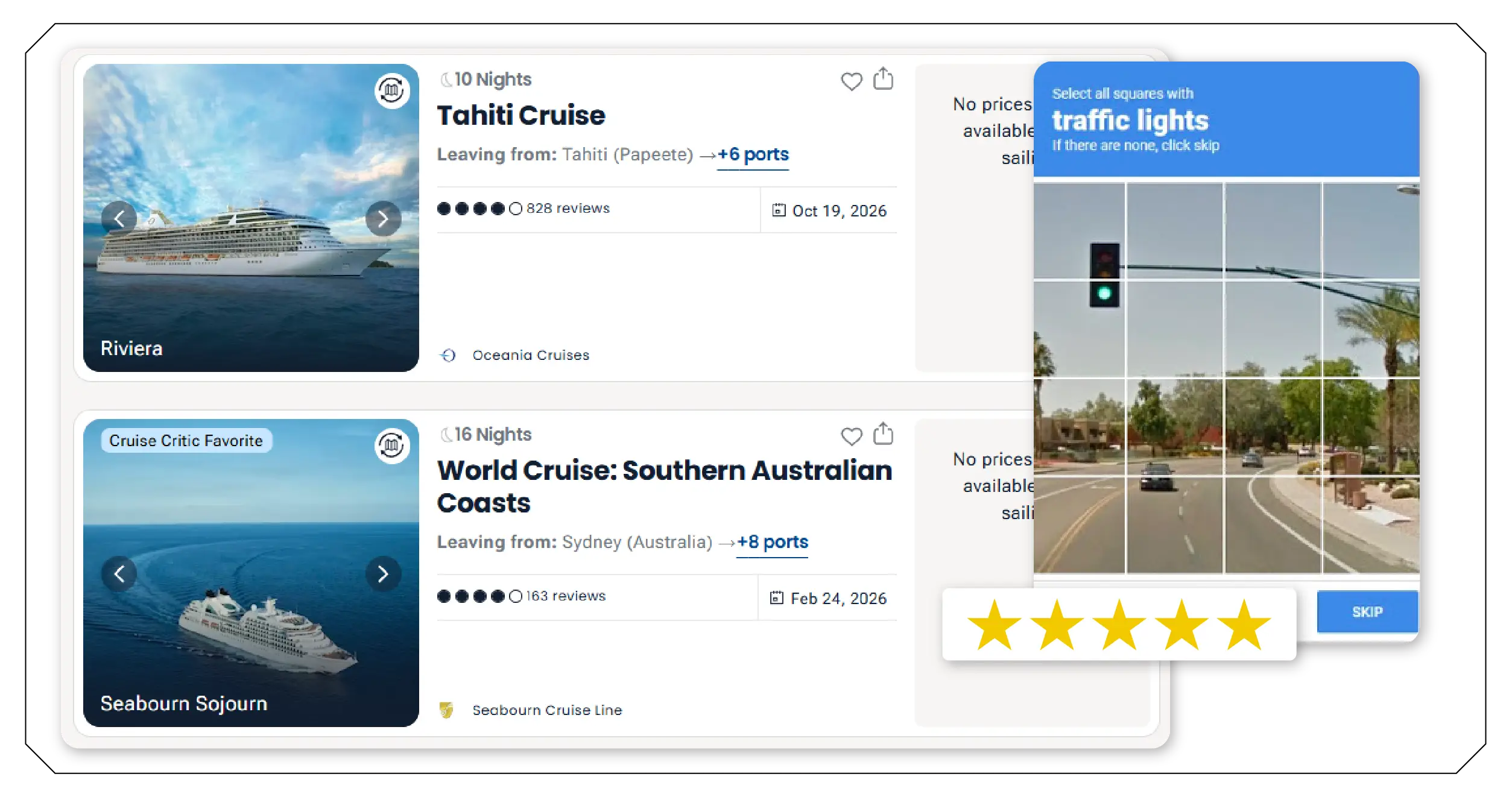
While scraping offers significant advantages, there are challenges:
- Dynamic Website Content: Cruise Critic uses dynamic content loading, requiring tools like Selenium for accurate extraction.
- Anti-Scraping Measures: Websites often implement CAPTCHA or IP blocks to prevent automated scraping. Rotating proxies and ethical scraping practices are crucial.
- Data Privacy: Analysts must comply with legal and ethical guidelines to protect user privacy while extracting publicly available data.
- Data Volume: Large volumes of reviews require efficient storage solutions and processing capabilities.
Addressing these challenges ensures the collection of high-quality data suitable for meaningful insights.
Integration with Global Cruise Route Data
When combined with external datasets like the Global Cruise Route Dataset, Cruise Critic reviews provide even greater value. Analysts can:
- Compare passenger satisfaction: across different routes.
- Assess popularity: of emerging destinations.
- Identify seasonal patterns: in cruise demand.
- Evaluate route impact: Analyze the effect of route changes on passenger ratings.
This integration enhances predictive modeling and supports strategic decisions for both cruise operators and travel agencies.
How Travel Scrape Can Help You?
- Detailed Review Collection: We gather passenger reviews, including ratings and feedback on cabins, excursions, dining, and onboard experiences.
- Itinerary and Route Insights: We extract cruise itineraries, port details, and schedules to create a structured dataset for analysis.
- Real-Time Monitoring: Our solutions track passenger feedback continuously, providing up-to-date insights for timely decision-making.
- Data Cleaning and Organization: We transform raw data into clean, structured formats ready for analysis and reporting.
- Actionable Analytics Support: We provide insights on cabin preferences, excursion popularity, and overall passenger satisfaction to help improve services and strategies.
Conclusion
Scraping Cruise Critic U.S. reviews offers a wealth of information that empowers cruise operators, travel agencies, and analysts to make data-driven decisions. By combining passenger feedback with itinerary and cabin information, businesses can improve services, optimize offerings, and stay ahead of market trends.
The use of Real-time Cruise Critic U.S. review data extraction ensures that insights remain current, enabling agile responses to emerging trends and passenger preferences. Coupled with Travel Scraping API Services , this approach streamlines data collection and integrates seamlessly into business intelligence workflows. Additionally, Cruise review scraping for cabin and excursion trends allows cruise operators to tailor offerings, enhance guest experiences, and maximize operational efficiency.
In an increasingly competitive travel market, leveraging Cruise Critic data is no longer optional—it is essential. By implementing robust scraping strategies and advanced analytics, businesses can unlock the full potential of passenger reviews, ultimately delivering unforgettable cruise experiences while driving growth and customer loyalty.
Ready to elevate your travel business with cutting-edge data insights? Get in touch with Travel Scrape today to explore how our end-to-end data solutions can uncover new revenue streams, enhance your offerings, and strengthen your competitive edge in the travel market.